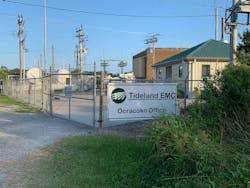Microgrid Helps North Carolina Island Recover from Hurricane Dorian’s Devastating Blow
Thanks to its microgrid, North Carolina’s Ocracoke Island was able to restore power three days after Hurricane Dorian sent a tidal wave smashing into its coast line, causing massive flooding.
Initially, both the grid and the microgrid went out of operation when the hurricane struck September 6, and flood waters rose 13 feet. Local service provider, Tideland Electric Membership Corp. (TEMC) said it had no choice but to shut down the microgrid given the wind and water.
“Dorian was a particularly catastrophic storm for Ocracoke that resulted in historic flooding on the island,” said Lisa Crawley, spokesperson for North Carolina’s Electric Cooperatives. “Because of flooding and structural damage, electric meters were pulled from nearly 400 homes — 28% of the island’s meters — making it impossible to deliver electric service to them.”
She added: “The good news is that, when flood waters subsided, after safety inspections to confirm equipment was not damaged, the microgrid’s diesel generator did play a role in restoring power to the island sooner than if restoration were solely dependent upon transmission service.”
TEMC restored microgrid service to the Outer Banks’ island September 9 along with fallen power lines. The next day grid power was also restored.
An island microgrid laboratory
Ocracoke’s population swells from a permanent resident population of some 950 to some 7,000 or more with the onset of summer and the influx of tourists who come to enjoy its North Atlantic Ocean beaches. Electricity is particularly expensive on the remote island — demand charges can run as high as 57 cents of every dollar spent on electricity. Furthermore, overhead power lines are exposed to the elements, leaving them vulnerable to high winds, storms and salt water.
A member of NCEC, TEMC and the electric co-op association carried out an initial initiative to improve grid service on Ocracoke back in 1990. It was then the project partners installed a 3-MW diesel generator to serve as a peaking power plant. Power became more affordable a TEMC spokesperson told Microgrid Knowledge.
NCEC and TEMC followed that up in January 2017 with the announcement they had formed a joint venture to install a hybrid microgrid on Ocracoke that combined a 15-kW rooftop solar PV array on top of the diesel power plant. A PowerSecure battery system stores power produced by the solar energy array, diesel generators and grid, while a Tesla controller manages microgrid power dispatch as grid conditions change.
Ocracoke Island’s overhead power lines are vulnerable in hurricanes. Photo by Elisa Wood
Twelve miles of overhead distribution line provide grid access to island residents and businesses along the route, infrastructure that is owned and managed by TEMC, a not for profit electric cooperative.
Microgrid incorporates demand response
The microgrid was designed to enhance reliability and resilience, lower utility bills and test a residential peak-demand shaving trial.
The peak-shaving service went down along with the microgrid when Dorian struck, but it has otherwise proved successful.
“One unique aspect of the Ocracoke microgrid is that it does incorporate demand-side response components, including smart thermostats and water heater controls,” Crawley said.
A total of 276 smart ecobee smart thermostats and 30 smart water heaters are connected to the microgrid and participating in the demand-side management program, she said.
“Many of the homes that suffered severe flooding and structural damage were also hosts to demand response thermostats, and as electrical repairs and county inspections occur, those meters are being reinstalled,” Crawley said.
Also See Elisa Wood’s blog “Ocracoke Island: Legends of Black Beard, Dorian and the Microgrid” on Real Energy Writers.
Ocracoke is living up to TEMC and NCEC’s expectations regarding its potential as a laboratory to test microgrid capabilities and performance.
“As with every storm, Dorian posed unique challenges and serves as a significant learning opportunity for us about how microgrids can be deployed and how we can further develop this technology to provide added resiliency and other benefits to our members moving forward,” Crawley concluded.
Join our Linkedin Group, Distributed Energy Resources, to discuss how DERs are transforming the electric power industry.
